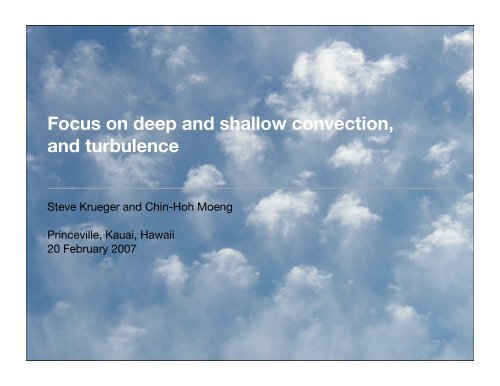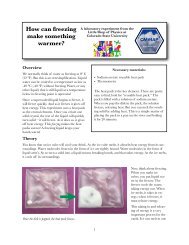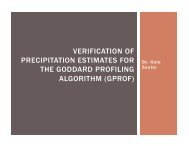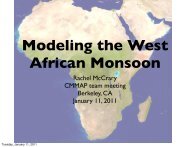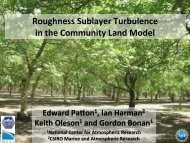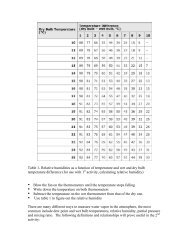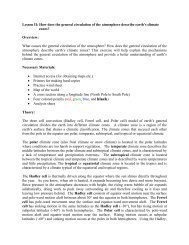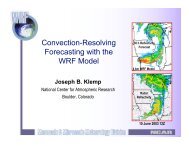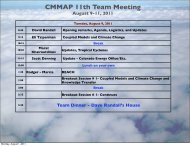Focus on deep and shallow convection, and turbulence - cmmap
Focus on deep and shallow convection, and turbulence - cmmap
Focus on deep and shallow convection, and turbulence - cmmap
Create successful ePaper yourself
Turn your PDF publications into a flip-book with our unique Google optimized e-Paper software.
<str<strong>on</strong>g>Focus</str<strong>on</strong>g> <strong>on</strong> <strong>deep</strong> <strong>and</strong> <strong>shallow</strong> c<strong>on</strong>vecti<strong>on</strong>,<br />
<strong>and</strong> <strong>turbulence</strong><br />
Steve Krueger <strong>and</strong> Chin-Hoh Moeng<br />
Princeville, Kauai, Hawaii<br />
20 February 2007
10,000 km<br />
Scales of Atmospheric Moti<strong>on</strong><br />
1000 km 100 km 10 km 1 km 100 m 10 m<br />
Planetary<br />
waves<br />
Extratropical<br />
Cycl<strong>on</strong>es<br />
Cumul<strong>on</strong>imbus<br />
Mesoscale<br />
clouds<br />
C<strong>on</strong>vective Systems<br />
Cumulus<br />
clouds<br />
Turbulence =><br />
Global Climate Model<br />
(GCM)<br />
Cloud System Resolving<br />
Model (CSRM)<br />
Large Eddy Simulati<strong>on</strong><br />
(LES) Model<br />
Multiscale Modeling Framework
from Arakawa <strong>and</strong> Jung (2003)
Boundary layer clouds in<br />
<strong>deep</strong>-c<strong>on</strong>vecti<strong>on</strong>-resolving models (DCRMs)<br />
• DCRMs are CRMs with horiz<strong>on</strong>tal<br />
grid sizes of 4 km or more.<br />
• Used in MMF, GCRMs (global<br />
CRMs), <strong>and</strong> tropical cycl<strong>on</strong>e<br />
models.<br />
• In MMF <strong>and</strong> GCRMs, DCRMs are<br />
expected to represent all types of<br />
cloud systems.<br />
• However, many cloud-scale<br />
circulati<strong>on</strong>s are not resolved by<br />
DCRMs.<br />
• Representati<strong>on</strong>s of SGS<br />
circulati<strong>on</strong>s currently used in<br />
DCRMs can be improved.
Boundary layers in<br />
<strong>deep</strong> precipitating c<strong>on</strong>vective cloud systems<br />
• Tropical c<strong>on</strong>vective cloud<br />
systems may organize too<br />
readily in the FRCGC GCRM<br />
<strong>and</strong> in MMF GCMs.<br />
• Possible causes:<br />
• C<strong>on</strong>vectively-generated cold<br />
pools are too str<strong>on</strong>g.<br />
• Boundary layer stabilizati<strong>on</strong><br />
due to <strong>shallow</strong> c<strong>on</strong>vecti<strong>on</strong> is<br />
under-estimated.<br />
• Poor horiz<strong>on</strong>tal resoluti<strong>on</strong> may<br />
c<strong>on</strong>tribute to both.
Shallow cumulus clouds<br />
<strong>and</strong> mesoscale organizati<strong>on</strong><br />
• Typical DCRMs grid sizes are<br />
too large to resolve <strong>shallow</strong><br />
cumulus.<br />
• A DCRM with a suitable SGS<br />
parameterizati<strong>on</strong> should be<br />
able to represent <strong>shallow</strong><br />
cumulus <strong>and</strong> resolved<br />
mesoscale organizati<strong>on</strong>.<br />
• LES can be used to provide a<br />
benchmark simulati<strong>on</strong>.
Outline of this talk<br />
•Introducti<strong>on</strong><br />
•Objectives of focus<br />
•Scope <strong>and</strong><br />
relati<strong>on</strong>ship to old<br />
WGs<br />
•Science issues<br />
•Meeting the objectives
Introducti<strong>on</strong><br />
• Objectives of focus:<br />
Improve the representati<strong>on</strong> of SGS c<strong>on</strong>vecti<strong>on</strong> <strong>and</strong> <strong>turbulence</strong> in <strong>deep</strong>c<strong>on</strong>vecti<strong>on</strong>-resolving<br />
models (DCRMs), for use in MMFs, GCRMs, <strong>and</strong> NWP.<br />
• Scope <strong>and</strong> relati<strong>on</strong>ship to old WGs:<br />
• Extensi<strong>on</strong>s, evaluati<strong>on</strong>s, <strong>and</strong> applicati<strong>on</strong>s of the prototype MMF(s)<br />
• Development <strong>and</strong> testing of improved parameterizati<strong>on</strong>s of microphysics <strong>and</strong><br />
radiati<strong>on</strong> for use in CSRMS, MMFs, <strong>and</strong> GCRMs<br />
• Development <strong>and</strong> testing of improved parameterizati<strong>on</strong>s of boundary layer<br />
clouds <strong>and</strong> <strong>turbulence</strong> for use in CSRMS, MMFs, <strong>and</strong> GCRMs<br />
• Accelerated improvement of c<strong>on</strong>venti<strong>on</strong>al parameterizati<strong>on</strong>s<br />
• Optimal use of computati<strong>on</strong>al <strong>and</strong> data storage resources<br />
• Knowledge-transfer to climate modeling centers<br />
• Knowledge transfer to numerical weather predicti<strong>on</strong> centers
Science Issues<br />
Representati<strong>on</strong> of the following cloud systems <strong>and</strong> boundary layer<br />
regimes in DCRMs:<br />
• Deep precipitating c<strong>on</strong>vective<br />
• Transiti<strong>on</strong> from <strong>shallow</strong> to <strong>deep</strong> c<strong>on</strong>vecti<strong>on</strong><br />
• Diurnal cycle of <strong>shallow</strong> c<strong>on</strong>vecti<strong>on</strong> over l<strong>and</strong><br />
• Trade cumulus<br />
• Marine stratocumulus<br />
• Cold-air outbreaks over mid-latitude oceans<br />
• C<strong>on</strong>vective plumes from leads during winter<br />
• Boundary layers over inhomogenous surfaces or terrain
Meeting the Objectives<br />
Develop <strong>and</strong> test improved representati<strong>on</strong>s of SGS c<strong>on</strong>vecti<strong>on</strong> <strong>and</strong> <strong>turbulence</strong><br />
in DCRMs.<br />
• Proposed parameterizati<strong>on</strong>s<br />
• PDF/HOC: Cheng & Xu, Lappen & R<strong>and</strong>all<br />
• Two-scale MMF: DCRM plus boundary-layer-eddy-resolving model (ERM)<br />
• Additi<strong>on</strong>al physics to be included<br />
• Effects of surface inhomogeniety (elevati<strong>on</strong>, l<strong>and</strong> surface properties): both<br />
resolved by the DCRM <strong>and</strong> SGS<br />
• Proposed evaluati<strong>on</strong> methods<br />
• Analysis of <strong>and</strong> comparis<strong>on</strong> to benchmark simulati<strong>on</strong>s<br />
• Comparis<strong>on</strong> to observati<strong>on</strong>al datasets
Boundary-layer Clouds in a Multiscale<br />
Modeling Framework (MMF)<br />
Anning Cheng , Kuan-Man Xu , Yali Luo,<br />
Jiundar Chern, <strong>and</strong> Wei-Kuo Tao
Joint PDF of total water <strong>and</strong> liquid<br />
water potential temperature<br />
LES PDF<br />
double Gaussian PDF<br />
single Gaussian PDF
C<strong>on</strong>tinental <strong>shallow</strong> cumuli (ARM)<br />
LES PDF<br />
double Gaussian PDF<br />
single Gaussian PDF
R<strong>and</strong>all, D. A., Q. Shao, <strong>and</strong> C.-H. Moeng 1992: A<br />
Sec<strong>on</strong>d-Order Bulk Boundary-Layer Model. J. Atmos.<br />
Sci., 49, 1903-1923.<br />
Lappen, C.-L, <strong>and</strong> D. A. R<strong>and</strong>all, 2001: Towards a unified<br />
parameterizati<strong>on</strong> of the boundary layer <strong>and</strong> moist<br />
c<strong>on</strong>vecti<strong>on</strong>. Part I. A new type of mass-flux model. J.<br />
Atmos. Sci., 58, 2021-2036.<br />
These papers show that:<br />
• Mass flux methods can be married with higher-order<br />
closure.<br />
• With this approach, the triple-moment terms of the<br />
sec<strong>on</strong>d moment equati<strong>on</strong>s can either advect or<br />
diffuse, depending <strong>on</strong> the regime.
Proposed Evaluati<strong>on</strong> Methods<br />
•Benchmark simulati<strong>on</strong>s<br />
•Large-domain LES (e.g., 100 km x 100 km domain,<br />
0.1 km grid size)<br />
•Compare to DCRM results using various SGS<br />
parameterizati<strong>on</strong>s.<br />
•Compare to SCM results.<br />
•Analyze results to gain insight into scale interacti<strong>on</strong>s,<br />
etc.
High-Resoluti<strong>on</strong> Simulati<strong>on</strong> of Shallow-to-Deep<br />
C<strong>on</strong>vecti<strong>on</strong> Transiti<strong>on</strong> over L<strong>and</strong><br />
(Khairoutdinov <strong>and</strong> R<strong>and</strong>all 2006)<br />
Figure 8. PDF of cloud size as a functi<strong>on</strong> of height shown for three different simulati<strong>on</strong> times. Mean <strong>and</strong><br />
st<strong>and</strong>ard deviati<strong>on</strong>s are shown by the white <strong>and</strong> yellow lines, respectively.<br />
150 km x 150 km, 100 m grid size, 6 h
Grid-size dependence in a large domain LES<br />
•RICO trade wind cumulus case: 19 Jan 2005<br />
•C<strong>on</strong>trol simulati<strong>on</strong>: 100 m horiz<strong>on</strong>tal grid size, 40 km x<br />
40 km domain, 24 h simulati<strong>on</strong><br />
•Grid-size dependence simulati<strong>on</strong>s: 500 m, 1000 m,<br />
2000 m, 4000 m horiz<strong>on</strong>tal grid sizes, otherwise<br />
unchanged from c<strong>on</strong>trol<br />
•Next: stereo images of clouds at 12 h
100 m
500 m
1000 m
2000 m
4000 m
100 m
500 m
1000 m
2000 m
4000 m
100 m<br />
Figure 12:
Avg’d to 500 m<br />
log 10<br />
of Liquid Water Path (g/m 2 ), hour 12<br />
40<br />
35<br />
3<br />
30<br />
2.5<br />
25<br />
2<br />
y (km)<br />
20<br />
1.5<br />
15<br />
10<br />
1<br />
5<br />
0.5<br />
0<br />
0 5 10 15 20 25 30 35 40<br />
x (km)
Avg’d to 1000 m<br />
log 10<br />
of Liquid Water Path (g/m 2 ), hour 12<br />
40<br />
35<br />
3<br />
30<br />
2.5<br />
25<br />
2<br />
y (km)<br />
20<br />
1.5<br />
15<br />
10<br />
1<br />
5<br />
0.5<br />
0<br />
0 5 10 15 20 25 30 35 40<br />
x (km)
1000 m<br />
log 10<br />
of Liquid Water Path (g/m 2 ), hour 12<br />
40<br />
35<br />
3<br />
30<br />
2.5<br />
25<br />
2<br />
y (km)<br />
20<br />
1.5<br />
15<br />
10<br />
1<br />
5<br />
0.5<br />
0<br />
0 5 10 15 20 25 30 35 40<br />
x (km)
1<br />
Cloud Fracti<strong>on</strong><br />
0.9<br />
0.8<br />
0.7<br />
cloud fracti<strong>on</strong><br />
0.6<br />
0.5<br />
0.4<br />
0.3<br />
100 m<br />
500 m<br />
0.2 1000 m<br />
2000 m<br />
4000 m<br />
0.1<br />
0 200 400 600 800 1000 1200 1400<br />
time (min)<br />
Figure 1:
last 6 hrs 100 m 500 m 1000 m 2000 m 4000 m<br />
cloud fracti<strong>on</strong> 0.18 0.28 0.58 0.87 0.94<br />
LWP (g/m 2 ) 23.9 26.7 46.0 69.1 96.7<br />
precip rates (mm/hr) 0.003 0.022 0.050 0.038 0.070<br />
Table 1: Statistics from the last 6 hrs
5000<br />
4500<br />
4000<br />
Water Vapor Mixing Ratio<br />
100 m<br />
500 m<br />
1000 m<br />
2000 m<br />
4000 m<br />
3500<br />
height (m)<br />
3000<br />
2500<br />
2000<br />
1500<br />
1000<br />
500<br />
0<br />
0 2 4 6 8 10 12 14 16<br />
water vapor mixing ratio (g/kg)<br />
Figure 3:
5000<br />
4500<br />
4000<br />
Cloud Water Mixing Ratio<br />
100 m<br />
500 m<br />
1000 m<br />
2000 m<br />
4000 m<br />
3500<br />
height (m)<br />
3000<br />
2500<br />
2000<br />
1500<br />
1000<br />
500<br />
0<br />
0 0.02 0.04 0.06 0.08 0.1 0.12 0.14 0.16 0.18 0.2<br />
cloud water mixing ratio (g/kg)<br />
Figure 2:
5000<br />
4500<br />
4000<br />
Rain Water Mixing Ratio<br />
100 m<br />
500 m<br />
1000 m<br />
2000 m<br />
4000 m<br />
3500<br />
height (m)<br />
3000<br />
2500<br />
2000<br />
1500<br />
1000<br />
500<br />
0<br />
0 1 2 3 4 5 6 7<br />
rain water mixing ratio (g/kg)<br />
x 10 !3<br />
Figure 4:
Proposed Evaluati<strong>on</strong> Methods<br />
•Observati<strong>on</strong>al datasets<br />
•High-resoluti<strong>on</strong> cloud properties from satellites:<br />
MODIS, ISCCP, etc<br />
•Vertical structure of clouds: CloudSat, ARM MMCR,<br />
TRMM<br />
•High-resoluti<strong>on</strong> hourly precipitati<strong>on</strong> from rain gage<br />
<strong>and</strong> unbiased radar<br />
•Surface mes<strong>on</strong>et observati<strong>on</strong>s of T, RH, p, u, v<br />
•Aircraft-based measurements during field<br />
experiments


